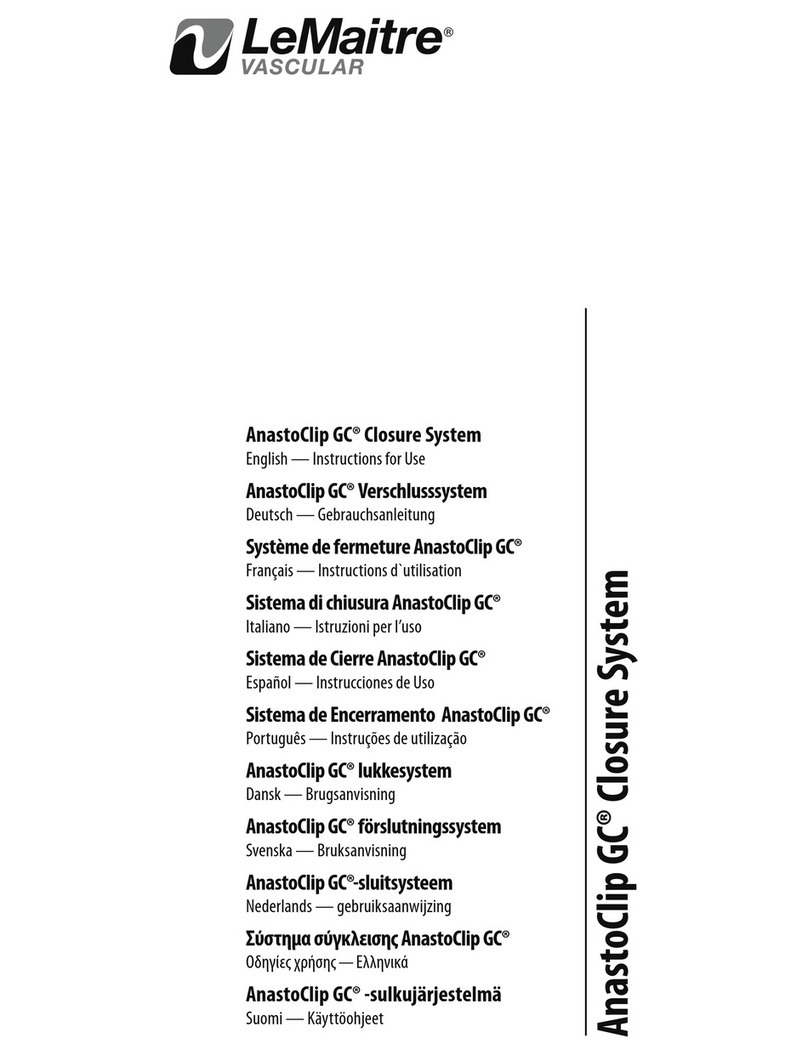
7
Omniow® II biosynthetische Gefäßprothese
Gebrauchsanleitung – Deutsch
Beschreibung
Die Omniow® II Gefäßprothese ist aus einem Polyesternetz innerhalb einer Schafsgewebematrix aus Kollagenbrillen konstruiert.
Die Prothese ist in einer Glutaraldehydlösung sterilisiert.
Die Prothese wird steril und nicht-pyrogen in einer Lösung aus 50 % Äthanol geliefert. Die Prothese bleibt steril, es sei denn, die primäre
Verpackung ist geönet oder beschädigt.
Die gerade Omniow II Gefäßprothese sitzt auf einem Glasdorn, der sich in einer Glasröhre bendet. Ein Haken verhindert, dass die
Prothese beim Herausnehmen aus der Glasröhre vom Dorn rutscht. Durchmesser und Mindestlänge der Prothese sind auf dem Etikett auf
der Glasröhre angegeben.
Die gekrümmte Omniow II Gefäßprothese bendet sich in einem sterilen, exiblen inneren Beutel, der von einem äußeren Beutel
umgeben ist. Der Durchmesser und die Mindestlänge der Prothese sind auf dem Etikett am äußeren Beutel angegeben.
Die Omniow II Gefäßprothese wird als MR-sicher angesehen.
Indikationen
Die Omniow II Gefäßprothese ist indiziert für den Ersatz, die Rekonstruktion, den Bypass oder die Reparatur von erkrankten Gefäßen bei
Patienten, die unter Okklusions- oder Aneurysma-Krankheiten leiden, bei Traumapatienten, die einen Gefäßersatz benötigen, oder bei
Patienten, die einen Gefäßzugang wie z. B. zur Hämodialyse benötigen.
Die gerade Omniow II Gefäßprothese ist für folgende Indikationen bestimmt:
1. Zur Umgehung, für den Ersatz oder zur Rekonstruktion von erkrankten oder verletzten Blutgefäßen
2. Zur Reparatur von peripheren Gefäßen
3. Für den arteriovenösen Zugang, wenn eine gerade Konguration erforderlich ist
Die gekrümmte Omniow II Gefäßprothese ist für den arteriovenösen Zugang vorgesehen, wenn eine Schlaufenkonguration erforderlich ist.
Warnhinweise
1. Die Omniow II Prothese NICHT resterilisieren. Sie wird steril und nichtpyrogen geliefert. Die Prothese sofort nach dem Önen
der Verpackung verwenden und ungebrauchte Teile entsorgen.
2. Die Prothese NICHT verwenden, wenn die primäre Verpackung beschädigt ist, da die Sterilität beeinträchtigt sein könnte.
3. Die Prothese NICHT verwenden, wenn der Glasdorn zerbrochen ist.
4. Die Prothese NICHT verwenden, wenn sie nicht vollständig mit der Aufbewahrungslösung bedeckt ist.
5. Die Prothese NICHT repositionieren, nachdem das Tunnelierinstrument entfernt wurde.
6. Die gekrümmte Prothese während der Vorbereitung oder Implantation NICHT geradebiegen, da dies die Netz-Gewebe-
Kontaktstelle unterbricht.
7. Die gerade Prothese NICHT zur Herstellung eines schlaufenförmigen arteriovenösen Zugangs verwenden, da dies zu einer
Knickbildung führen könnte.
8. Den Körper der Prothese NICHT ziehen, strecken, verdrehen, zusammendrücken oder -kneifen.
9. Ablationsmethoden, wie z. B. Cutting- Ballons, Laser oder Radiofrequenzablation, dürfen NICHT mit der Omniow II Prothese
verwendet werden.
10. Es darf NICHT versucht werden, die Prothese mit Ballonangioplastie oder einer Stentplatzierung zu dilatieren.
11. Die Omniow II Prothese darf nur von entsprechend geschulten Chirurgen implantiert werden.
12. Der Einsatz der Omniow II Prothese in der Koronararterie wurde nicht.
Technische Informationen/Vorsichtshinweise
1. Sicherstellen, dass das Spülverfahren durchgeführt wurde, um vor der Implantation der Prothese die Aufbewahrungslösung zu
entfernen. Ein Versäumnis kann zu einer Okklusion führen. Während des Verfahrens die Prothese mit steriler physiologischer
Kochsalzlösung feucht halten.
2. Zur Passage der Prothese muss unbedingt ein Tunnelierinstrument verwendet werden. Ein Versäumnis kann eine Störung des
biosynthetischen Materials verursachen und zu Okklusion, Dilatation oder Aneurysmabildung führen. Der Innendurchmesser
des Tunnelierinstruments muss mindestens 3 mm größer sein als der angegebene Innendurchmesser der Prothese.
3. Sicherstellen, dass die Prothese bei der Passage durch das Tunnelierinstrument nicht verdreht wird, da dies zu einer Okklusion
führen könnte.
4. Ein Abklemmen mit einem Metallinstrument vermeiden, da dies die Prothese beschädigen und zu Okklusion, Dilatation oder
Aneurysmabildung führen könnte. Ist ein Abklemmen nicht zu vermeiden, nur atraumatische Klemmen verwenden und
wiederholtes oder übermäßiges Abklemmen in der gleichen Position auf der Prothese vermeiden.
5. Die Prothese hat nur eine minimale Längselastizität. Sicherstellen, dass die Prothese auf die richtige Länge zugeschnitten ist.
Wenn sie zu kurz ist, kann sie die Naht herausziehen und die Gefahr eines anastomotischen Aneurysmas verursachen. Wenn sie
zu lang ist, kann sie abknicken und zur Okklusion führen.






























